Player Engagement Analysis of a Business Simulation Game from Physiological, Psychological and Behavioral Perspectives: A Case Study
Abstract
1. Introduction
2. Background
2.1. Engagement in the PE
2.2. Measuring Player Engagement in Serious Games
3. Materials and Methods
3.1. Participants
3.2. The BSG
- Screen 1: Agricultural section. Beginning of the supply chain, where the planting of grains and cattle raising, raw material for supplying the stores, are defined.
- Screen 2: Feedlot. Stage in which the cattle are fattened and slaughtered and, in the sequence, the hamburger is produced.
- Screen 3: Fast Food. Represents the chain of stores, comprising the process of production and sale of the snack.
- Screen 4: Headquarters. Place where the player gets to know the most detailed information of the business and makes decisions at a strategic level that are reflected in the whole process.
3.3. Data Collection Devices Used in the Experiment
3.3.1. Hemoencephalogram (HEG)
3.3.2. Eye Tracking (ET)
3.4. Player Engagement Research Model Adopted for the BSG Experiment
3.5. Metodology of the Experiment
- Answer a pretest questionnaire containing questions about the participant’s profile and their perceptions about using the BSG;
- Position the two devices and make calibrations/adjustments for the tests;
- Read a tutorial introducing the basic principles of the game operation and features;
- Carry out the proposed activity using the BSG;
- Answer a posttest questionnaire, with questions about the learning experience after using the BSG as well as aspects related to the features and design elements perceived in the tool.
4. Results
- Intervals of at least 10 s where there is an up/down of the moving average of the oxygen rate with more than 80% of the points in the interval.
- Variation of the moving average of the oxygenation rate ≥20 (up or down) recorded at time intervals ≥5 s. These criteria allowed for the selection of five to nine moments of the game with a significant rise and/or fall in the HEG rate for each participant. Subsequently, these periods were used as references to identify the corresponding average pupil dilatation diameter (PDD) in addition to the minimum and maximum diameter and the variation between these two values, provided by the ET, in the different intervals. The situation experienced by each player was also identified and classified into one of seven different categories: game start (GS); critical situation (CS); game over (GO); ethical dilemma (ED); operational decision (OD); strategic thinking (ST); or insight (IS). All these results from the 10 players were grouped to provide cross-referencing and critical analysis of the information and can be seen in Table A1. It should be noted that although the 10 participants underwent complete collection, 2 of them (P3 and P8) had problems capturing the signals while reading the tutorial, and this period was discarded. In these two cases, it was decided not to require the participant to reread the tutorial, as it would have been exhausting and could have compromised motivation and, consequently, their performance in the game, considered the most important source of information for the experiment. The other data from P3 and P8, referring to the game period, were normally used in the research.
- The HEG ratio is not an indicator of the greater or lesser activation of the prefrontal cortex that allows for comparing it in isolation between different people, considering that each human being has a different level of cerebral oxygenation, in addition to the influence of other aspects. Therefore, the experiment monitored this variable from the point of view of its behavior throughout the game for each participant, and allowed, through the individual graphs and later grouped according to Figure 5, to analyze possible trends that allow inferring patterns adopted by the players.
- The variable monitored by the ET, which was the pupil dilation diameter, varies from 1.5 mm to 8 mm, and is influenced by aspects such as age and ambient light, which means that each participant has a range of variation [62]. This does not mean that a higher pupil dilation diameter than others indicated a higher level of attention. Therefore, the experiment individually analyzed the trend of the variable over time, and a subsequent comparison of these trends as a reflection of visual behavior from the beginning to the end of the game suggested patterns associated with engagement in the activity.
5. Discussion
6. Conclusions
- Indicate trends in the flow and attentional behavior of the game as a whole;
- Establish not always direct relationships between the variables in the different situations proposed, as was the case of moments involving strategic thinking;
- Provide analysis of specific periods, relating the results of variables with pre- and posttest data, mainly to justify situations in which players’ behaviors are different.
Author Contributions
Funding
Institutional Review Board Statement
Informed Consent Statement
Data Availability Statement
Acknowledgments
Conflicts of Interest
Appendix A
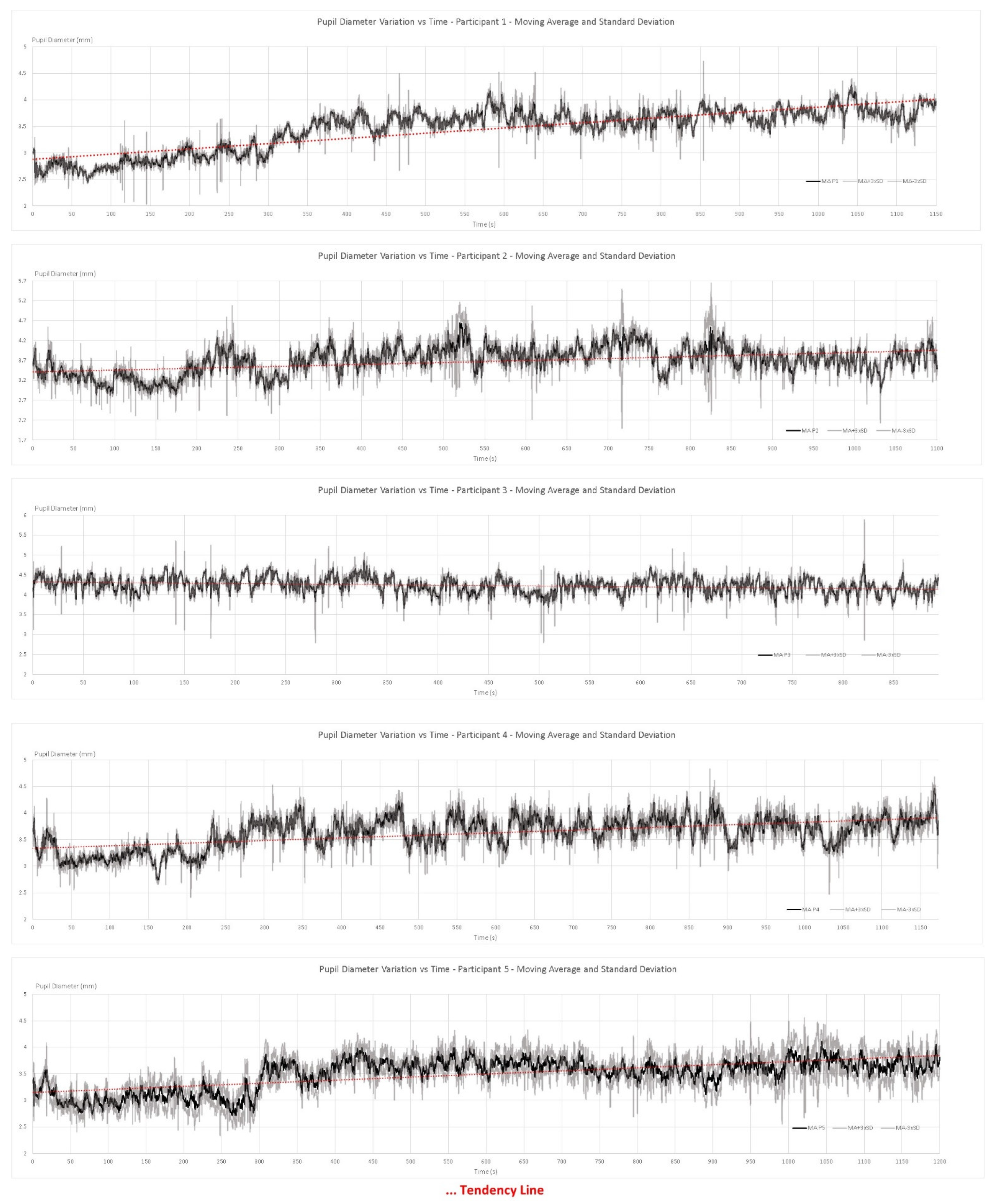
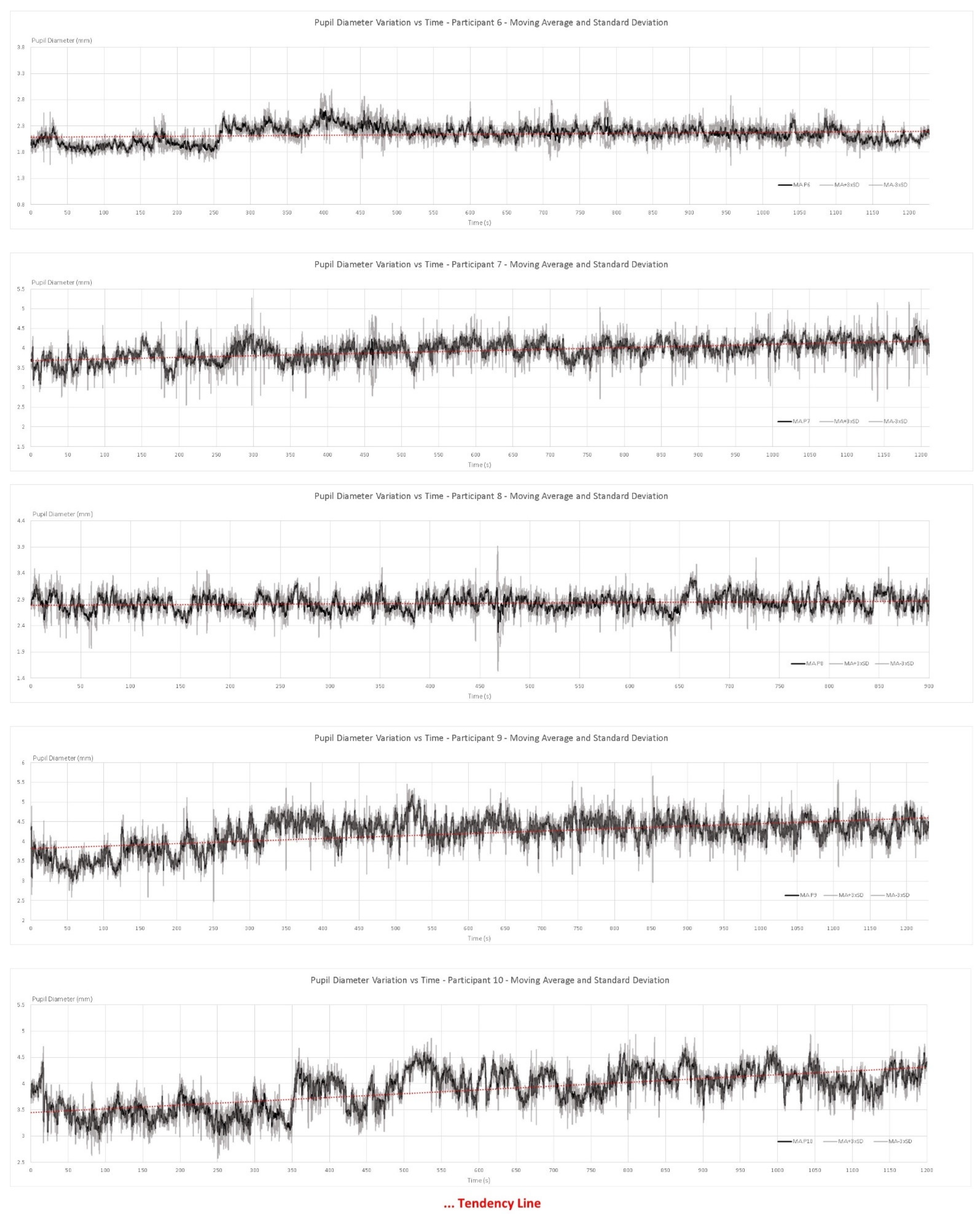
Appendix B
| Player | Time | (I) Time Period (s) | (II) BSG Situation during the Play | (III) HEG Ratio Behavior | (IV) PDD min (mm) | (V) PDD máx (mm) | (VI) PDD avg. (mm) | (VII) PDD Variation (mm) |
|---|---|---|---|---|---|---|---|---|
| P1 | 1 | 273–283 | ED | Fall | 2.9155 | 3.3187 | 3.1372 | 0.4032 |
| 2 | 342–354 | GS | Rise | 3.2588 | 3.4870 | 3.3779 | 0.2282 | |
| 3 | 432–443 | CS | Rise | 3.2150 | 3.4557 | 3.3532 | 0.2407 | |
| 4 | 523–590 | ED | Rise | 3.4468 | 4.1689 | 3.6972 | 0.7221 | |
| 5 | 609–621 | CS | Fall | 3.4892 | 3.9327 | 3.7390 | 0.4435 | |
| 6 | 628–640 | OD | Rise | 3.3810 | 3.9618 | 3.6737 | 0.5808 | |
| 7 | 1118–1131 | ST | Rise | 3.3550 | 4.2808 | 3.7544 | 0.9258 | |
| 8 | 949–960 | ED | Fall | 3.5320 | 3.9697 | 3.7820 | 0.4377 | |
| 9 | 1099–1111 | CS | Fall | 3.4877 | 3.9375 | 3.7071 | 0.4498 | |
| P2 | 1 | 6–18 | IS | Fall | 3.1539 | 3.7445 | 3.3722 | 0.5906 |
| 2 | 161–175 | ST | Rise | 2.8378 | 3.2531 | 3.0526 | 0.4153 | |
| 3 | 213–265 | ED | Rise | 3.2034 | 4.2710 | 3.7751 | 1.0676 | |
| 4 | 327–339 | ED | Fall | 3.2694 | 3.9066 | 3.6250 | 0.6372 | |
| 5 | 424–441 | OD | Rise | 3.5927 | 4.2246 | 3.8863 | 0.6319 | |
| 6 | 506–518 | ST | Rise | 3.7283 | 4.3915 | 4.0462 | 0.6632 | |
| 7 | 652–664 | CS | Fall | 3.6455 | 4.3097 | 3.9654 | 0.6642 | |
| 8 | 762–879 | CS | Rise | 3.1114 | 4.5328 | 3.8237 | 1.4214 | |
| 9 | 885–899 | OD | Fall | 3.2337 | 3.9946 | 3.6891 | 0.7609 | |
| P3 | 1 | 347–359 | CS | Fall | 3.9083 | 4.5551 | 4.3327 | 0.6468 |
| 2 | 419–431 | OD | Rise | 4.1199 | 4.7076 | 4.4349 | 0.5877 | |
| 3 | 564–582 | ED | Fall | 3.8330 | 4.4401 | 4.1846 | 0.6071 | |
| 4 | 631–642 | OD | Rise | 3.9843 | 4.5652 | 4.2976 | 0.5809 | |
| 5 | 669–684 | CS | Fall | 4.0768 | 4.3559 | 4.2131 | 0.2791 | |
| 6 | 808–864 | ED | Fall | 3.7910 | 4.5412 | 4.2144 | 0.7502 | |
| 7 | 1064–1115 | CS | Fall | 3.7347 | 4.4502 | 4.1382 | 0.7155 | |
| 8 | 1145–1165 | CS | Rise | 3.7093 | 4.7729 | 4.1600 | 1.0636 | |
| P4 | 1 | 350–380 | CS | Rise | 3.2175 | 4.1204 | 3.5652 | 0.9029 |
| 2 | 381–392 | OD | Fall | 3.3601 | 3.9655 | 3.6127 | 0.6054 | |
| 3 | 608–623 | ED | Rise | 3.2416 | 4.0911 | 3.6229 | 0.8495 | |
| 4 | 924–936 | CS | Rise | 3.4552 | 3.8541 | 3.6516 | 0.3989 | |
| 5 | 937–945 | OD | Fall | 3.5924 | 4.0267 | 3.8347 | 0.4343 | |
| P5 | 1 | 182–193 | ED | Rise | 2.9232 | 3.3531 | 3.1506 | 0.4299 |
| 2 | 336–352 | OD | Fall | 3.4259 | 3.7923 | 3.6682 | 0.3664 | |
| 3 | 699-709 | CS | Rise | 3.5561 | 3.8322 | 3.7310 | 0.2761 | |
| 4 | 773–784 | OD | Fall | 3.3534 | 3.7958 | 3.6067 | 0.4424 | |
| 5 | 989–1001 | CS | Rise | 3.3372 | 3.9779 | 3.6532 | 0.6407 | |
| 6 | 1060–1072 | CS | Rise | 3.6029 | 3.9547 | 3.7961 | 0.3518 | |
| 7 | 1072–1117 | OD | Fall | 3.3994 | 3.9522 | 3.6580 | 0.5528 | |
| P6 | 1 | 20–46 | IS | Rise | 1.8887 | 2.2917 | 2.0491 | 0.4030 |
| 2 | 81–112 | IS | Fall | 1.7663 | 1.9910 | 1.8942 | 0.2247 | |
| 3 | 321–332 | ED | Fall | 2.1713 | 2.4799 | 2.3547 | 0.3086 | |
| 4 | 430–450 | GO | Rise | 2.1277 | 2.3878 | 2.2697 | 0.2601 | |
| 5 | 455–474 | OD | Fall | 2.1560 | 2.5897 | 2.3195 | 0.4337 | |
| 6 | 587–597 | CS | Fall | 2.0899 | 2.3438 | 2.2236 | 0.2539 | |
| 7 | 621–640 | CS | Rise | 2.0154 | 2.3149 | 2.1499 | 0.2995 | |
| P7 | 1 | 53–124 | IS | Rise | 3.2747 | 4.0762 | 3.6520 | 0.8015 |
| 2 | 240–266 | IS | Rise | 3.4729 | 3.8900 | 3.6503 | 0.4171 | |
| 3 | 282–298 | GS | Fall | 3.7925 | 4.4462 | 4.1296 | 0.6537 | |
| 4 | 504–599 | CS | Rise | 3.2993 | 4.4773 | 3.9932 | 1.1780 | |
| 5 | 747–870 | CS | Rise | 3.4226 | 4.3826 | 4.0142 | 0.9600 | |
| 6 | 1192–1204 | CS | Rise | 3.6641 | 4.5744 | 4.1327 | 0.9103 | |
| P8 | 1 | 329–340 | ED | Fall | 2.5513 | 3.0386 | 2.7272 | 0.4873 |
| 2 | 422–432 | OD | Rise | 2.6842 | 2.9737 | 2.8389 | 0.2895 | |
| 3 | 507–518 | OD | Rise | 2.5505 | 2.8084 | 2.6714 | 0.2579 | |
| 4 | 653–674 | ED | Rise | 2.5631 | 2.9446 | 2.7385 | 0.3815 | |
| 5 | 720–780 | CS | Rise | 2.2761 | 3.1305 | 2.8778 | 0.8544 | |
| 6 | 810–827 | OD | Fall | 2.5783 | 2.9157 | 2.7406 | 0.3374 | |
| 7 | 887–899 | OD | Fall | 2.5756 | 3.0623 | 2.8596 | 0.4867 | |
| 8 | 906–924 | IS | Rise | 2.6040 | 2.9818 | 2.8087 | 0.3778 | |
| 9 | 1109–1130 | ED | Fall | 2.6283 | 3.1873 | 2.9087 | 0.5590 | |
| P9 | 1 | 10–41 | IS | Rise | 2.9835 | 3.9353 | 3.4411 | 0.9518 |
| 2 | 117–156 | ED | Fall | 3.2328 | 4.3639 | 3.7994 | 1.1311 | |
| 3 | 156–177 | IS | Rise | 3.3948 | 4.0034 | 3.7315 | 0.6086 | |
| 4 | 256–267 | IS | Rise | 3.4911 | 4.1965 | 3.9241 | 0.7054 | |
| 5 | 535–550 | CS | Rise | 3.8763 | 4.9207 | 4.3356 | 1.0444 | |
| 6 | 703/719 | CS | Rise | 3.9724 | 4.6468 | 4.3417 | 0.6744 | |
| 7 | 784–795 | CS | Rise | 3.9978 | 4.7905 | 4.4542 | 0.7927 | |
| 8 | 803–833 | GO | Fall | 3.8058 | 4.8136 | 4.3551 | 1.0078 | |
| 9 | 890–950 | OD | Fall | 3.9966 | 4.8885 | 4.3823 | 0.8919 | |
| P10 | 1 | 46–58 | IS | Rise | 3.2025 | 3.6066 | 3.4473 | 0.4041 |
| 2 | 377–386 | ED | Fall | 3.6790 | 4.1176 | 3.8990 | 0.4386 | |
| 3 | 354–376 | IS | Rise | 3.6627 | 4.4119 | 4.0856 | 0.7492 | |
| 4 | 528–538 | ED | Fall | 3.8645 | 4.5475 | 4.3724 | 0.6830 | |
| 5 | 737–750 | ED | Fall | 3.5468 | 4.1789 | 3.8123 | 0.6321 | |
| 6 | 827–837 | ED | Fall | 3.8669 | 4.4601 | 4.2183 | 0.5932 | |
| 7 | 851–865 | CS | Rise | 3.8447 | 4.2299 | 4.0697 | 0.3852 | |
| 8 | 1082–1092 | CS | Rise | 3.8339 | 4.1826 | 4.0054 | 0.3487 | |
| Legend: BSG Situation along the game | ||||||||
| GS | Game start | Watching the Tutorial | ||||||
| CS | Critical situation | |||||||
| GO | Game Over | Playing the Game | ||||||
| ED | Ethical Dilemma | |||||||
| OD | Operational Decision | |||||||
| SD | Strategic Thinking | |||||||
| IS | Insight | |||||||
References
- Siddiqui, A.; Khan, M.; Akhtar, S. Supply Chain Simulator: A Scenario-Based Educational Tool to Enhance Student Learning. Comput. Educ. 2008, 51, 252–261. [Google Scholar] [CrossRef]
- Hernández-Lara, A.B.; Serradell-López, E. Student Interactions in Online Discussion Forums: Their Perception on Learning with Business Simulation Games. Behav. Inf. Technol. 2018, 37, 419–429. [Google Scholar] [CrossRef]
- García, J.; Cañadillas, I.; Charterina, J. Business Simulation Games with and without Supervision: An Analysis Based on the TAM Model. J. Bus. Res. 2016, 69, 1731–1736. [Google Scholar] [CrossRef]
- Lin, H.H.; Yen, W.C.; Wang, Y.S. Investigating the Effect of Learning Method and Motivation on Learning Performance in a Business Simulation System Context: An Experimental Study. Comput. Educ. 2018, 127, 30–40. [Google Scholar] [CrossRef]
- Eilon, S. Management Games. J. Oper. Res. Soc. 1963, 14, 137–149. [Google Scholar] [CrossRef]
- Diachkova, A.V.; Sandler, D.G.; Avramenko, E.S. Case of Using Simulation in Education for Business Analysts. Econ. Consult. 2020, 31, 104–114. [Google Scholar] [CrossRef]
- Toma, R.C.; Margarit, G.; Garais, G.; Matei, F. E-Learning Platform for Start-Up Simulation in Life Science and Business Field—A Useful Educational Tool. Sci. Pap. Manag. Econ. Eng. Agric. Rural. Dev. 2020, 20, 493–498. [Google Scholar]
- Kieras, D.; Polson, P.G. An Approach to the Formal Analysis of User Complexity. Int. J. Man-Mach. Stud. 1985, 22, 365–394. [Google Scholar] [CrossRef]
- Pelaez, J.J.C.; Peregrina, A.F.A.; García, Á.H.; Natale, E.A.; Pradas, S.I. Business Simulation Games as Learning Tools in Engineering Courses: Aiming for Inclusion. In Proceedings of the 2nd Virtual International Conference on Education, Innovation and ICT, Eindhoven, The Netherlands, 12–14 December 2017. [Google Scholar]
- Chiappe, D.; Conger, M.; Liao, J.; Caldwell, J.L.; Vu, K.-P.L. “Improving Multi-Tasking Ability through Action Videogames”: Corrigendum. Appl. Ergon. 2013, 44, 850. [Google Scholar] [CrossRef]
- Glass, B.D.; Maddox, W.T.; Love, B.C. Real-Time Strategy Game Training: Emergence of a Cognitive Flexibility Trait. PLoS ONE 2013, 8, 70350. [Google Scholar] [CrossRef]
- Csikszentmihalyi, M. Flow: The Psychology of Optimal Experience; Harper & Row: New York, NY, USA, 1990. [Google Scholar]
- Zhou, Y.; Calder, B.J.; Malthouse, E.C.; Hessary, Y.K. Not All Clicks Are Equal: Detecting Engagement with Digital Content. J. Media Bus. Stud. 2021, 19, 90–107. [Google Scholar] [CrossRef]
- Zaphiris, P.; Ang, C.S. HCI Issues in Computer Games. Interact. Comput. 2007, 19, 135–139. [Google Scholar] [CrossRef]
- Sánchez, J.L.G.; Vela, F.L.G.; Simarro, F.M.; Padilla-Zea, N. Playability: Analysing User Experience in Video Games. Behav. Inf. Technol. 2012, 31, 1033–1054. [Google Scholar] [CrossRef]
- Natkin, S.; Bernhaupt, R.; Tscheligi, M.; Lee, N.; Inakage, M. ACM Digital Library. In Association for Computing Machinery, Proceedings of the International Conference on Advances in Computer Entertainment Technology, Salzburg, Austria, 13–15 June 2007; ACM Press: New York, NY, USA, 2007; ISBN 9781595936400. [Google Scholar]
- Tsai, M.-J.; Huang, L.-J.; Hou, H.-T.; Hsu, C.-Y.; Chou, G.-L. Visual Behavior, Flow and Achievement in Game-BasedLearning. Comput. Educ. 2016, 98, 115–129. [Google Scholar] [CrossRef]
- Huynh, S.; Kim, S.; Ko, J.; Balan, R.K.; Lee, Y. EngageMon. Proc. ACM Interact. Mob. Wearable Ubiquitous Technol. 2018, 2, 1–27. [Google Scholar] [CrossRef]
- Mills, C.; D’Mello, S.; Lehman, B.; Bosch, N.; Strain, A.; Graesser, A. What Makes Learning Fun? Exploring the Influence of Choice and Difficulty on Mind Wandering and Engagement during Learning. In Artificial Intelligence in Education—16th International Conference, AIED 2013, Proceedings; Springer: Berlin/Heidelberg, Germany, 2013; pp. 71–80. [Google Scholar]
- Lehmann, J.; Lalmas, M.; Yom-Tov, E.; Dupret, G. Models of User Engagement. In User Modeling, Adaptation, and Personalization; Masthoff, J., Mobasher, B., Desmarais, M.C., Nkambou, R., Eds.; Springer: Berlin/Heidelberg, Germany, 2012; pp. 164–175. [Google Scholar]
- O’Brien, H.L.; Toms, E.G. What Is User Engagement? A Conceptual Framework for Defining User Engagement with Technology. J. Am. Soc. Inf. Sci. Technol. 2008, 59, 938–955. [Google Scholar] [CrossRef]
- Drachen, A.; Mirza-Babaei, P.; Nacke, L. Games User Research; Oxford University Press: Oxford, UK, 2018; ISBN 0198794843. [Google Scholar]
- Csikszentmihalyi, M.; Abuhamdeh, S.; Nakamura, J. Flow. Flow and the Foundations of Positive Psychology; Springer: Dordrecht, The Netherlands, 2021. [Google Scholar]
- Moizer, J.; Lean, J.; Dell’Aquila, E.; Walsh, P.; Keary, A.; O’Byrne, D.; di Ferdinando, A.; Miglino, O.; Friedrich, R.; Asperges, R.; et al. An Approach to Evaluating the User Experience of Serious Games. Comput. Educ. 2019, 136, 141–151. [Google Scholar] [CrossRef]
- Laamarti, F.; Eid, M.; el Saddik, A. An Overview of Serious Games. Int. J. Comput. Games Technol. 2014, 2014, 1–15. [Google Scholar] [CrossRef]
- Hookham, G.; Nesbitt, K. A Systematic Review of the Definition and Measurement of Engagement in Serious Games. In Proceedings of the Australasian Computer Science Week Multiconference, Sydney, Australia, 29 January 2019. [Google Scholar]
- Takatalo, J.; Häkkinen, J.; Kaistinen, J.; Nyman, G. Presence, Involvement, and Flow in Digital Games. In Evaluating User Experience in Games: Concepts and Methods; Springer: London, UK, 2010; pp. 23–46. ISBN 978-1-84882-962-6. [Google Scholar]
- Maheu-Cadotte, M.A.; Cossette, S.; Dubé, V.; Fontaine, G.; Mailhot, T.; Lavoie, P.; Cournoyer, A.; Balli, F.; Mathieu-Dupuis, G. Effectiveness of Serious Games and Impact of Design Elements on Engagement and Educational Outcomes in Healthcare Professionals and Students: A Systematic Review and Meta-Analysis Protocol. BMJ Open 2018, 8, e019871. [Google Scholar] [CrossRef]
- Guthier, B.; Dörner, R.; Martinez, H.P. Affective Computing in Games. In Artificial Intelligence in Education; Lecture Notes in Computer Science (including subseries Lecture Notes in Artificial Intelligence and Lecture Notes in Bioinformatics); Springer: Berlin/Heidelberg, Germany, 2016; Volume 9970, pp. 402–441. [Google Scholar] [CrossRef]
- Dörner, R.; Göbel, S.; Effelsberg, W.; Wiemeyer, J. Serious Games Foundations, Concepts and Practice; Springer: Cham, Switzerland, 2016; Volume 1, ISBN 978-3-319-40611-4. [Google Scholar]
- Kim, S.H.; Han, D.H.; Lee, Y.S.; Kim, B.N.; Cheong, J.H.; Han, S.H. Baduk (the Game of Go) Improved Cognitive Function and Brain Activity in Children with Attention Deficit Hyperactivity Disorder. Psychiatry Investig. 2014, 11, 143–151. [Google Scholar] [CrossRef]
- Derbali, L.; Frasson, C. Physiological Evaluation of Attention Getting Strategies during Serious Game Play. In Artificial Intelligence in Education; Lecture Notes in Computer Science (including subseries Lecture Notes in Artificial Intelligence and Lecture Notes in Bioinformatics); Springer: Berlin/Heidelberg, Germany, 2011; Volume 6738, pp. 447–449. [Google Scholar] [CrossRef]
- Sharma, K.; Giannakos, M. Multimodal Data Capabilities for Learning: What Can Multimodal Data Tell Us about Learning? Br. J. Educ. Technol. 2020, 51, 1450–1484. [Google Scholar] [CrossRef]
- Ninaus, M.; Kiili, K.; Wood, G.; Moeller, K.; Kober, S.E. To Add or Not to Add Game Elements? Exploring the Effects of Different Cognitive Task Designs Using Eye Tracking. IEEE Trans. Learn. Technol. 2020, 13, 847–860. [Google Scholar] [CrossRef]
- Mercier, J.; Avaca, I.L.; Whissell-Turner, K.; Paradis, A. Towards Modeling the Psychophysiology of Learning Interactions: The Effect of Agency on Arousal in Dyads Learning Physics with a Serious Computer Game. In Technology and Innovation in Learning, Teaching and Education; Springer: Cham, Switzerland, 2021; pp. 421–431. [Google Scholar] [CrossRef]
- Biercewicz, K.; Borawski, M. Examining the Degree of Engagement of a Participant in Economic Games Using Cognitive Neuroscience Techniques. In Experimental and Quantitative Methods in Contemporary Economics; Springer: Cham, Switzerland, 2020; pp. 201–216. ISBN 9783030302511. [Google Scholar]
- Gauthier, A.; Jenkinson, J. Designing Productively Negative Experiences with Serious Game Mechanics: Qualitative Analysis of Game-Play and Game Design in a Randomized Trial. Comput. Educ. 2018, 127, 66–89. [Google Scholar] [CrossRef]
- Johnsen, H.M.; Briseid, H.S.; Brodtkorb, K.; Slettebø, Å.; Fossum, M. Nursing Students’ Perceptions of Combining Hands-on Simulation with Simulated Patients and a Serious Game in Preparing for Clinical Placement in Home Healthcare: A Qualitative Study. Nurse Educ. Today 2021, 97, 104675. [Google Scholar] [CrossRef]
- Tang, J.S.Y.; Falkmer, M.; Chen, N.T.M.; Bölte, S.; Girdler, S. Designing a Serious Game for Youth with ASD: Perspectives from End-Users and Professionals. J. Autism Dev. Disord. 2019, 49, 978–995. [Google Scholar] [CrossRef]
- Cowley, B.; Ravaja, N. Learning in Balance: Using Oscillatory EEG Biomarkers of Attention, Motivation and Vigilance to Interpret Game-Based Learning. Cogent Educ. 2014, 1, 962236. [Google Scholar] [CrossRef]
- Monteiro, D.; Liang, H.-N.; Abel, A.; Bahaei, N.; de Cassia Monteiro, R. Evaluating Engagement of Virtual Reality Games Based on First and Third Person Perspective Using EEG and Subjective Metrics. In Proceedings of the 2018 IEEE International Conference on Artificial Intelligence and Virtual Reality AIVR, Taichung, Taiwan, 10–12 December 2018; pp. 53–60. [Google Scholar]
- Emmerich, K.; Bogacheva, N.; Bockholt, M.; Wendel, V. Operationalization and Measurement of Evaluation Constructs. In Entertainment Computing and Serious Games; Lecture Notes in Computer Science (including subseries Lecture Notes in Artificial Intelligence and Lecture Notes in Bioinformatics); Springer: Cham, Switzerland, 2016; Volume 9970, pp. 306–331. [Google Scholar] [CrossRef]
- Blignaut, A.S. Infinite Possibilities for Using Eyetracking for Mobile Serious Games in Order to Improve User Learning Experiences. In The Mobile Learning Voyage—From Small Ripples to Massive Open Waters; Communications in Computer and Information Science; Springer: Cham, Switzerland, 2015; Volume 560, pp. 70–83. [Google Scholar] [CrossRef]
- Gutjahr, M.O.; Ellermeier, W.; Hardy, S.; Göbel, S.; Wiemeyer, J. The Pupil Response as an Indicator of User Experience in a Digital Exercise Game. Psychophysiology 2019, 56, e13418. [Google Scholar] [CrossRef]
- Soler-Dominguez, J.L.; Camba, J.D.; Contero, M.; Alcañiz, M. A Proposal for the Selection of Eye-Tracking Metrics for the Implementation of Adaptive Gameplay in Virtual Reality Based Games. In Virtual, Augmented and Mixed Reality; Lecture Notes in Computer Science (including subseries Lecture Notes in Artificial Intelligence and Lecture Notes in Bioinformatics); Springer: Cham, Switzerland, 2017; Volume 10280, pp. 369–380. [Google Scholar] [CrossRef]
- Nacke, L.E. Games User Research and Physiological Game Evaluation. In Game User Experience Evaluation; Springer: Cham, Switzerland, 2015; pp. 63–86. [Google Scholar]
- Greco, M.; Baldissin, N.; Nonino, F. An Exploratory Taxonomy of Business Games. Simul. Gaming 2013, 44, 645–682. [Google Scholar] [CrossRef]
- Tragazikis, P.; Kirginas, S.; Gouscos, D. Digital Games for Entrepreneurial Learning, Innovation and Creativity: Examples and Evaluation Criteria. Int. J. Innov. Reg. Dev. 2012, 4, 314–337. [Google Scholar] [CrossRef]
- Sanchez, E.; van Oostendorp, H.; Fijnheer, J.D.; Lavoué, E. Gamification. In Encyclopedia of Education and Information Technologies; Springer: Cham, Switzerland, 2020; pp. 816–827. [Google Scholar]
- Albuquerque, R.M.; Ramos, D.K. Projetando Aprendizagem Utilizando Jogos Eletrônicos: Análise Do Jogo Educacional de Simulação McDonalds Game; Simpósio Brasileiro de Jogos e Entretenimento Digital (SBGames): Salvador, Brazil, 2011. [Google Scholar]
- Rodrak, S.; Wongsawat, Y. On the Classification of EEG/HEG-Based Attention Levels via Time-Frequency Selective Multilayer Perceptron for BCI-Based Neurofeedback System. In Proceedings of the 2012 Asia Pacific Signal and Information Processing Association Annual Summit and Conference, Hollywood, CA, USA, 3–6 December 2012. [Google Scholar]
- Lewien, R. GazeHelp: Exploring Practical Gaze-Assisted Interactions for Graphic Design Tools. In Proceedings of the ACM Symposium on Eye Tracking Research and Applications, Stuttgart, Germany, 25 May 2021; pp. 1–4. [Google Scholar]
- Denzin, N.K.; Lincoln, Y.S. (Eds.) Handbook of Qualitative Research, 3rd ed.; Sage: Thousand Oaks, CA, USA, 2005; Volume 24, p. 128. [Google Scholar]
- Lankshear, C.; Knobel, M. Digital Literacies: Concepts, Policies and Practices; Peter Lang Publishing: Bern, Switzerland, 2008. [Google Scholar]
- Hess, E.H.; Polt, J.M. Pupil Size in Relation to Mental Activity during Simple Problem-Solving. Science 1964, 143, 1190–1192. [Google Scholar] [CrossRef]
- Hess, E.H.; Polt, J.M. Pupil Size as Related to Interest Value of Visual Stimuli. Science 1960, 132, 349–350. [Google Scholar] [CrossRef] [PubMed]
- Sibley, C.; Coyne, J.; Baldwin, C. Pupil Dilation as an Index of Learning. Proc. Hum. Factors Ergon. Soc. 2011, 55, 237–241. [Google Scholar] [CrossRef]
- Salazar Olarte, C.A. La Pupilometría y El Eye Tracking Como Herramientas Del Neuromarketing. Vivat Acad. 2021, 154, 227–243. [Google Scholar] [CrossRef]
- Siegle, G.J.; Steinhauer, S.R.; Stenger, V.A.; Konecky, R.; Carter, C.S. Use of Concurrent Pupil Dilation Assessment to Inform Interpretation and Analysis of FMRI Data. Neuroimage 2003, 20, 114–124. [Google Scholar] [CrossRef]
- Kuchinsky, S.E.; Ahlstrom, J.B.; Vaden, K.I.; Cute, S.L.; Humes, L.E.; Dubno, J.R.; Eckert, M.A. Pupil Size Varies with Word Listening and Response Selection Difficulty in Older Adults with Hearing Loss. Psychophysiology 2012, 50, 23–34. [Google Scholar] [CrossRef]
- Skulmowski, A.; Bunge, A.; Kaspar, K.; Pipa, G.; Rocio Montoya, E. Forced-Choice Decision-Making in Modified Trolley Dilemma Situations: A Virtual Reality and Eye Tracking Study. Front. Behav. Neurosci. 2014, 8, 426. [Google Scholar] [CrossRef]
- Guyton, A.C.; Hall, J.E. Tratado de Fisiologia Médica, 11th ed.; Elsevier: Rio de Janeiro, Brazil, 2006. [Google Scholar]
- Gold, J.; Ciorciari, J. A Review on the Role of the Neuroscience of Flow States in the Modern World. Behav. Sci. 2020, 10, 137. [Google Scholar] [CrossRef]
- Konstan, J.A.; Chi, E.H.; Höök, K. SIGCHI (Group: U.S.). In Proceedings of the SIGCHI Conference on Human Factors in Computing Systems, Austin, USA, 5–10 May 2012; ISBN 9781450310154. [Google Scholar]
- White, M. Learn to Play: Designing Tutorials for Video Games; CRC Press: Boca Raton, FL, USA, 2014; ISBN 9780429095030. [Google Scholar]
- Ghali, R.; Chaouachi, M.; Derbali, L.; Frasson, C. Motivational Strategies to Support Engagement of Learners in Serious Games. In Proceedings of the ICAART 2014—Proceedings of the 6th International Conference on Agents and Artificial Intelligence, Angers, France, 6–8 March 2014; Volume 1, pp. 518–525. [Google Scholar] [CrossRef]
- Heitz, R.P.; Schrock, J.C.; Payne, T.W.; Engle, R.W. Effects of Incentive on Working Memory Capacity: Behavioral and Pupillometric Data. Psychophysiology 2008, 45, 119–129. [Google Scholar] [CrossRef]
- Wray, R.; Massey, L.; Medina, J.; Bolton, A. Increasing Engagement in a Cyber-Awareness Training Game; Springer: Cham, Switzerland, 2020; Volume 12197, ISBN 9783030504380. [Google Scholar]
- Lee, D.; Seo, H. Neural Basis of Strategic Decision Making. Trends Neurosci. 2016, 39, 40–48. [Google Scholar] [CrossRef]
- Seo, H.; Barraclough, D.J.; Lee, D. Lateral Intraparietal Cortex and Reinforcement Learning during a Mixed-Strategy Game. J. Neurosci. 2009, 29, 7278–7279. [Google Scholar] [CrossRef]
- Bohbot, V.D.; Lerch, J.; Thorndycraft, B.; Iaria, G.; Zijdenbos, A.P. Gray Matter Differences Correlate with Spontaneous Strategies in a Human Virtual Navigation Task. J. Neurosci. 2007, 27, 10078–10083. [Google Scholar] [CrossRef]
- Marshall, S.P. Identifying Cognitive State from Eye Metrics. Aviat. Space Environ. Med. 2007, 78, B165–B175. [Google Scholar]
- Spinks, J.A.; Zhang, J.X.; Fox, P.T.; Gao, J.H.; Hai Tan, L. More Workload on the Central Executive of Working Memory, Less Attention Capture by Novel Visual Distractors: Evidence from an FMRI Study. Neuroimage 2004, 23, 517–524. [Google Scholar] [CrossRef]
- Fiedler, S.; Glöckner, A. Attention and Moral Behavior. Curr. Opin. Psychol. 2015, 6, 139–144. [Google Scholar] [CrossRef]
- Serra-Sala, M.; Timoneda-Gallart, C.; Pérez-Álvarez, F. Evaluating Prefrontal Activation and Its Relationship with Cognitive and Emotional Processes by Means of Hemoencephalography (HEG). J. Neurother. 2012, 16, 183–195. [Google Scholar] [CrossRef][Green Version]
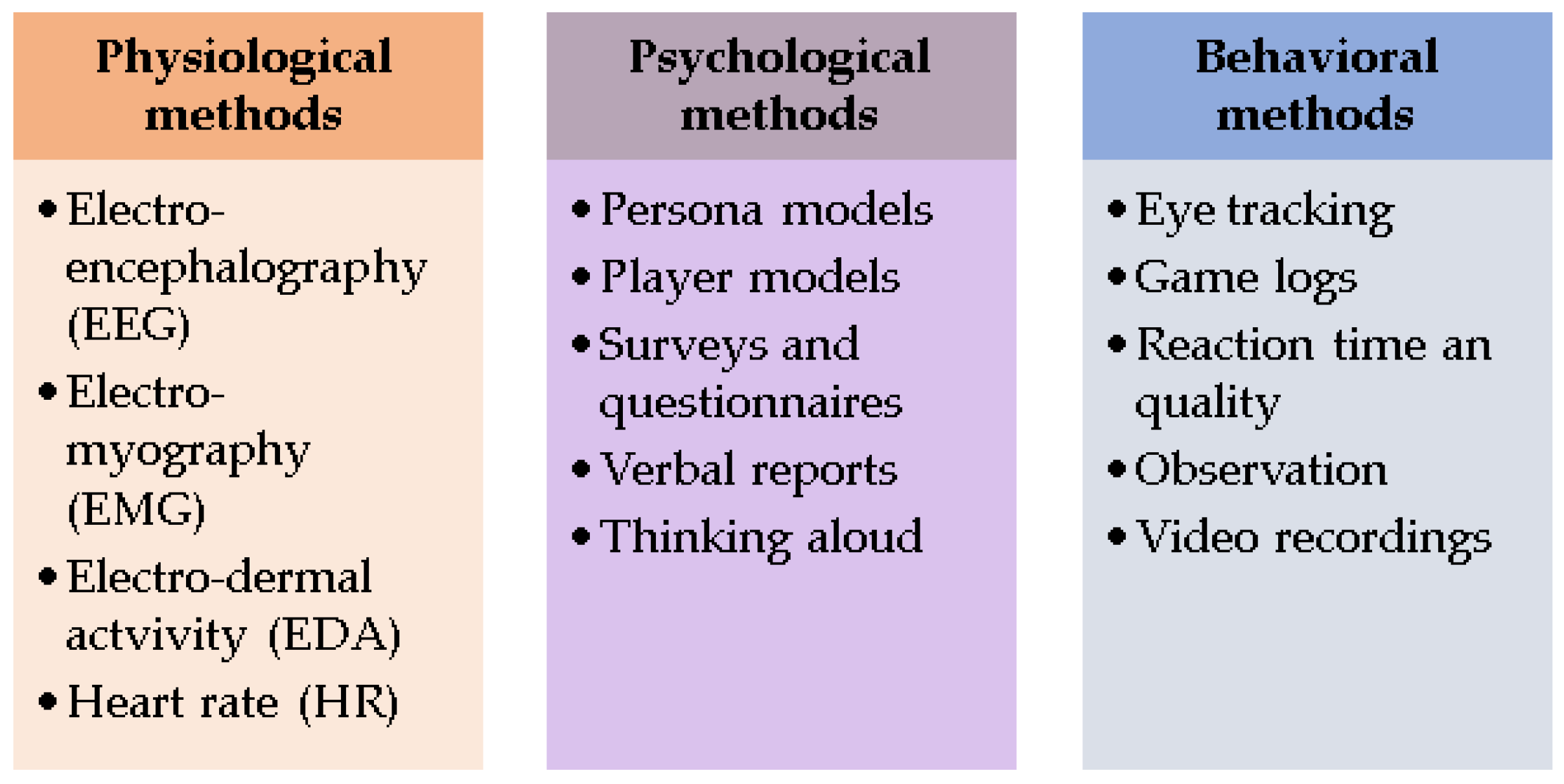
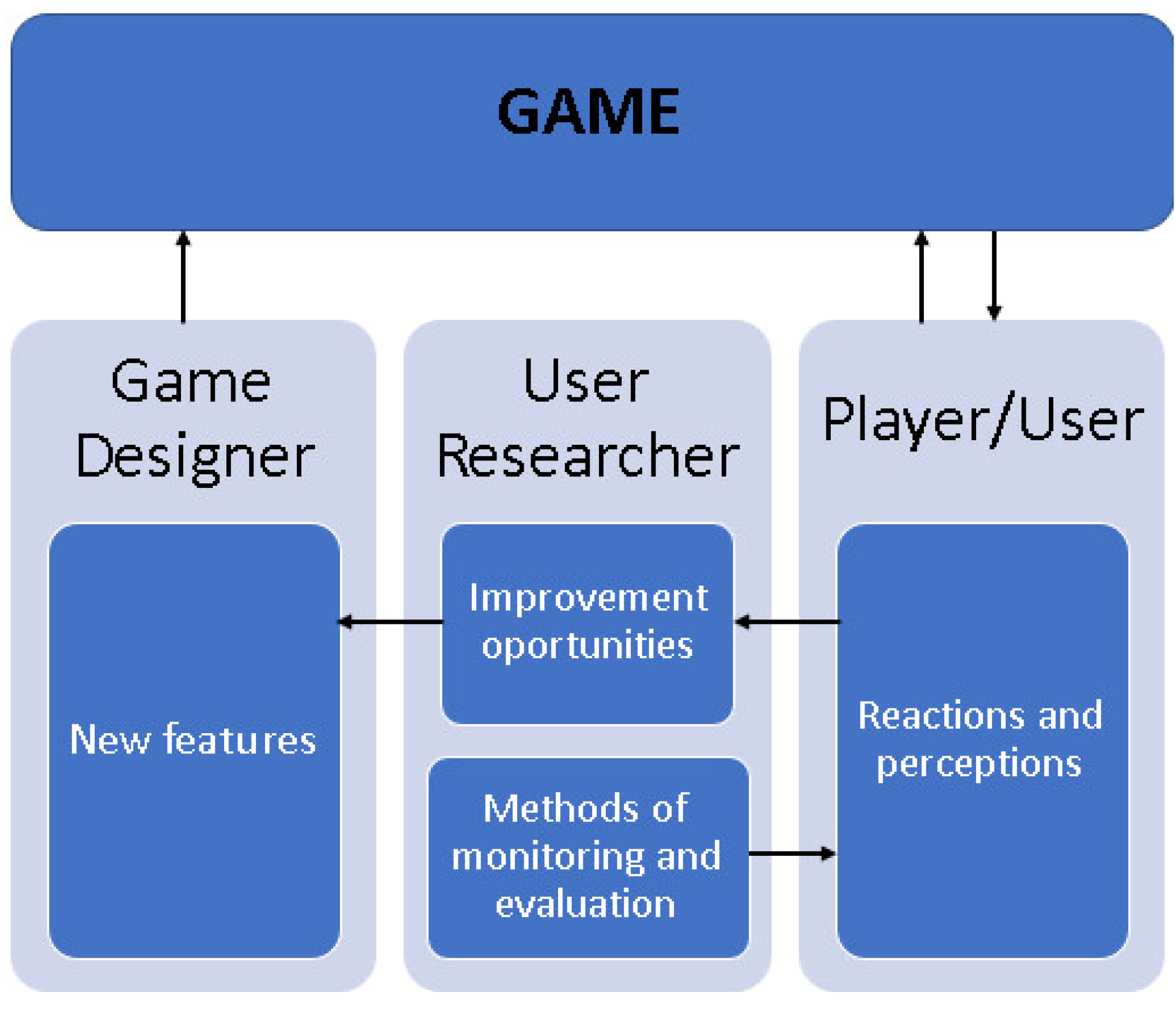
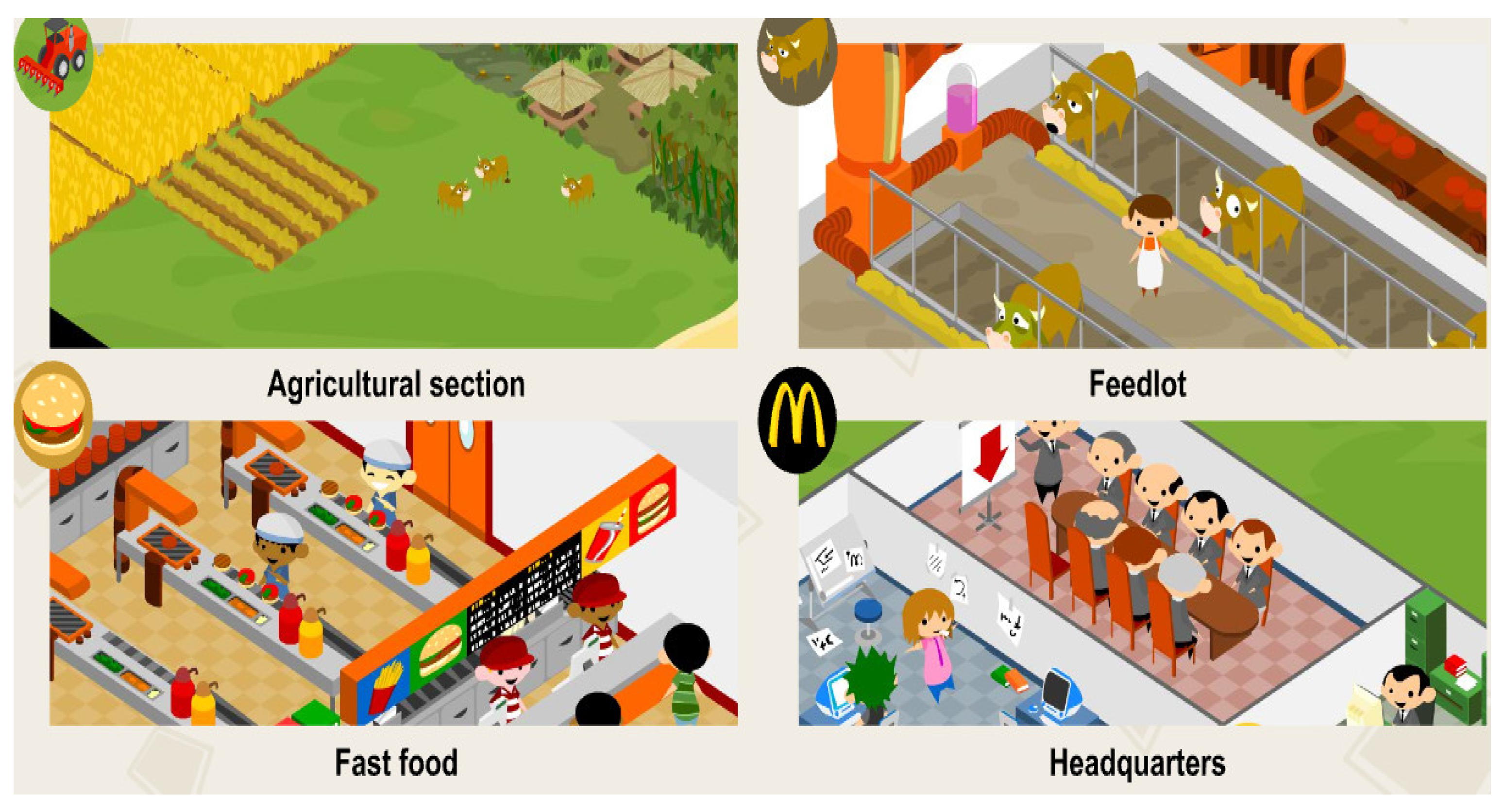
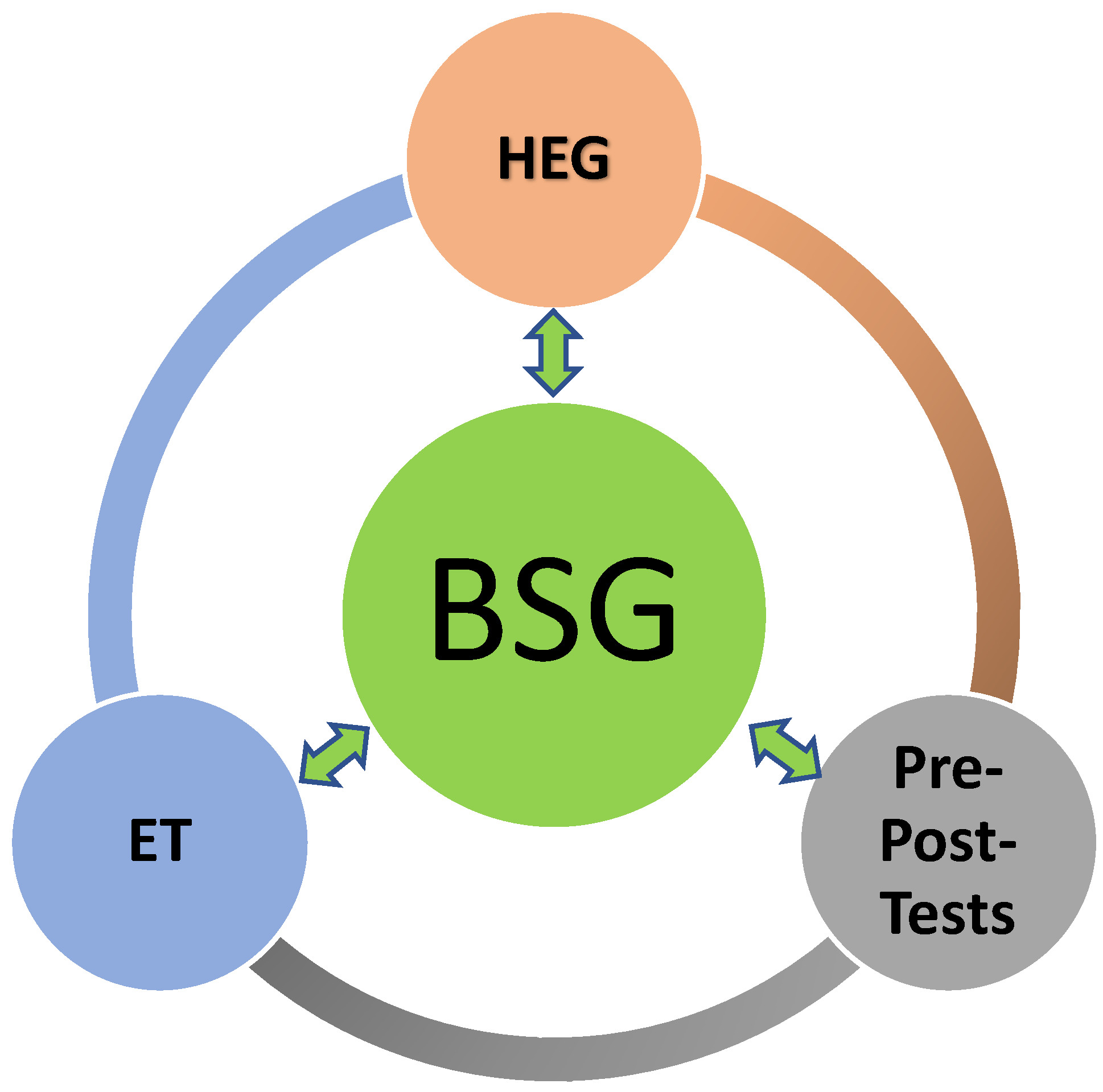
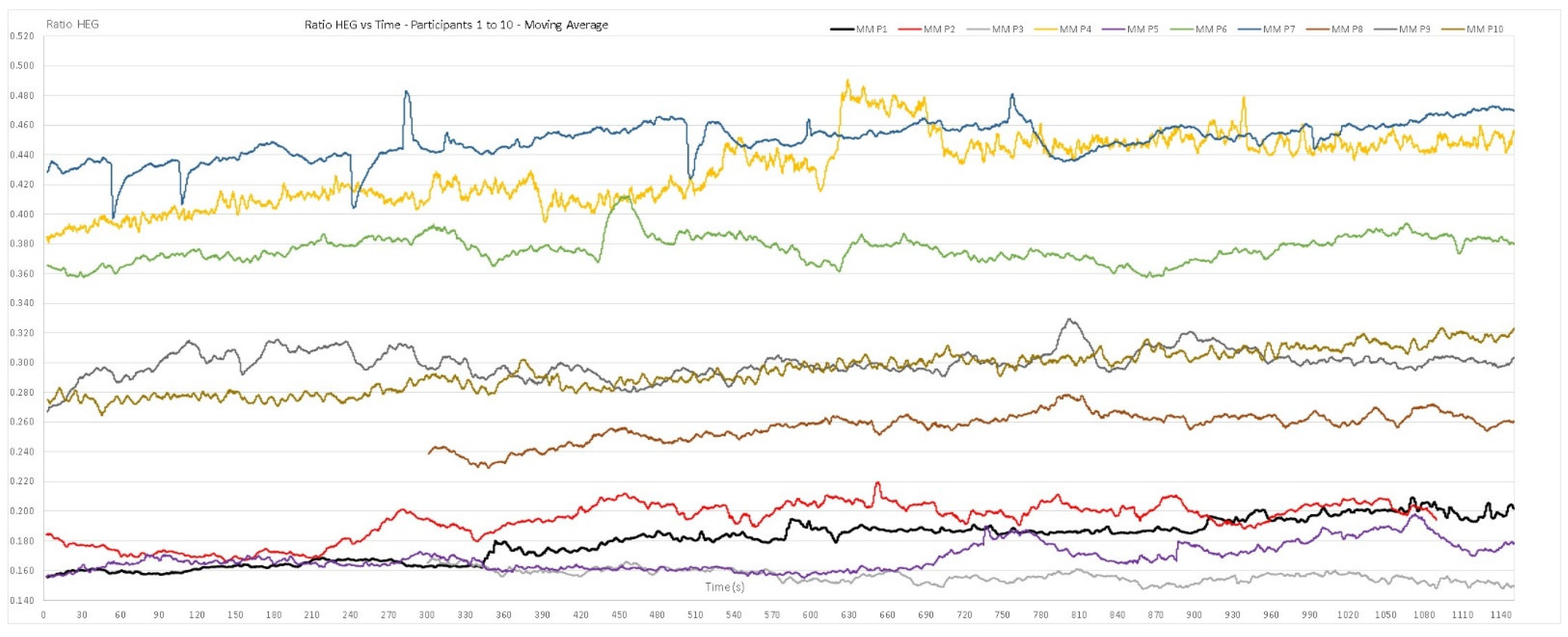
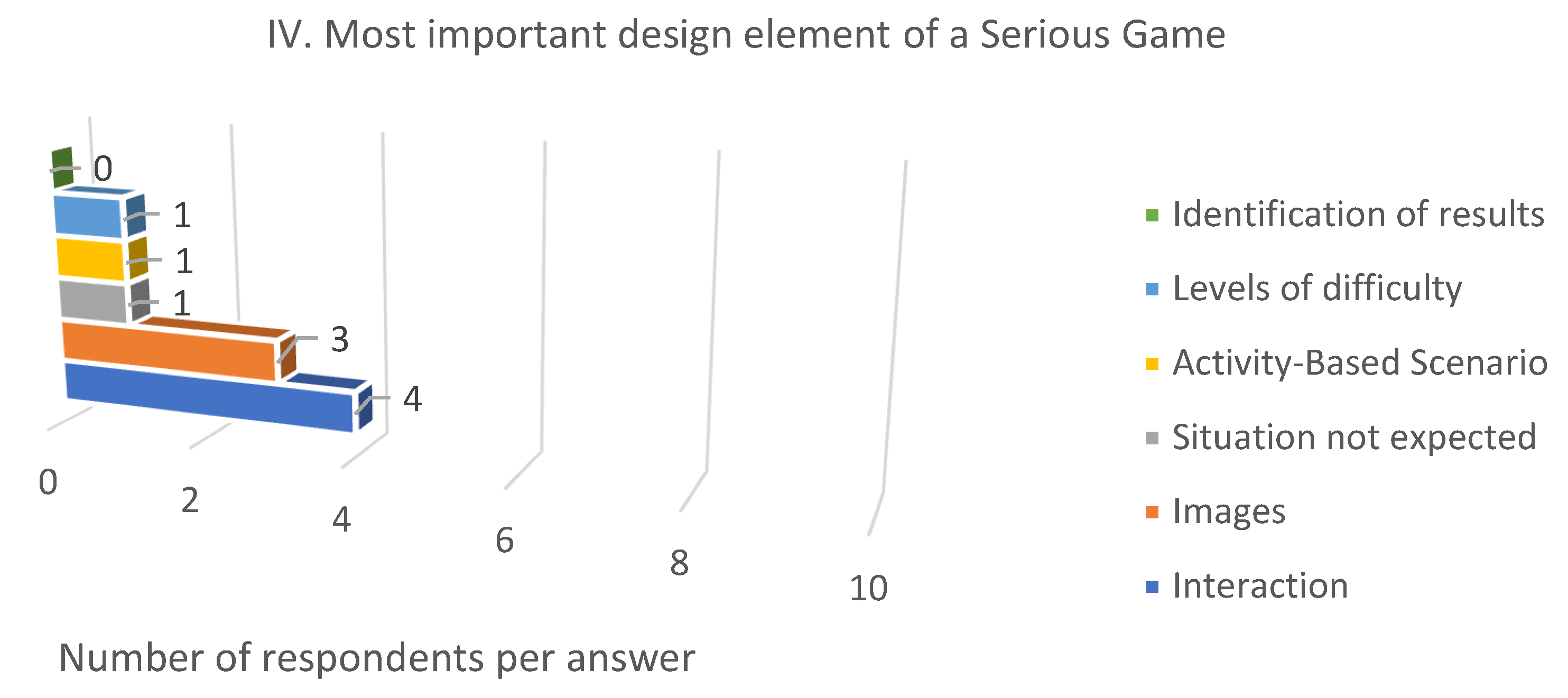
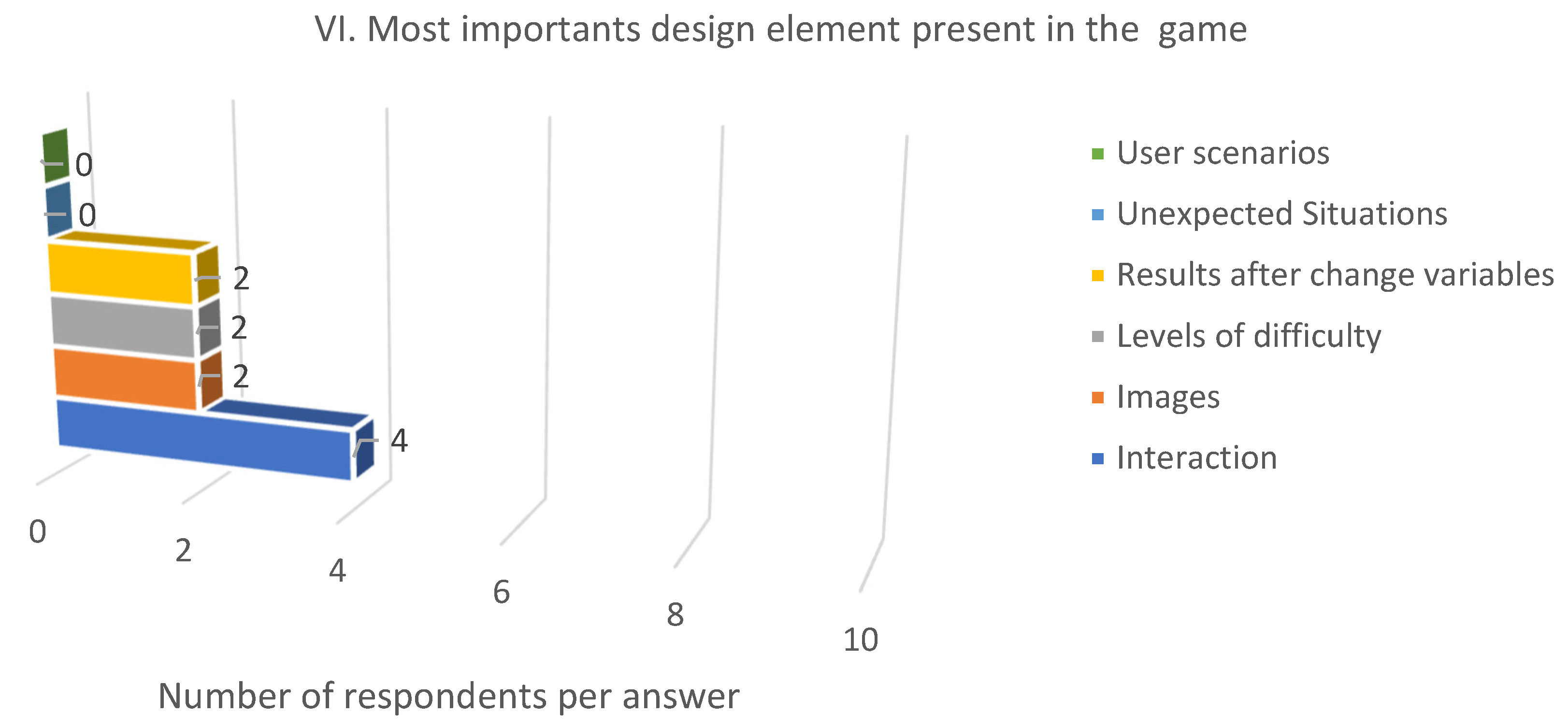
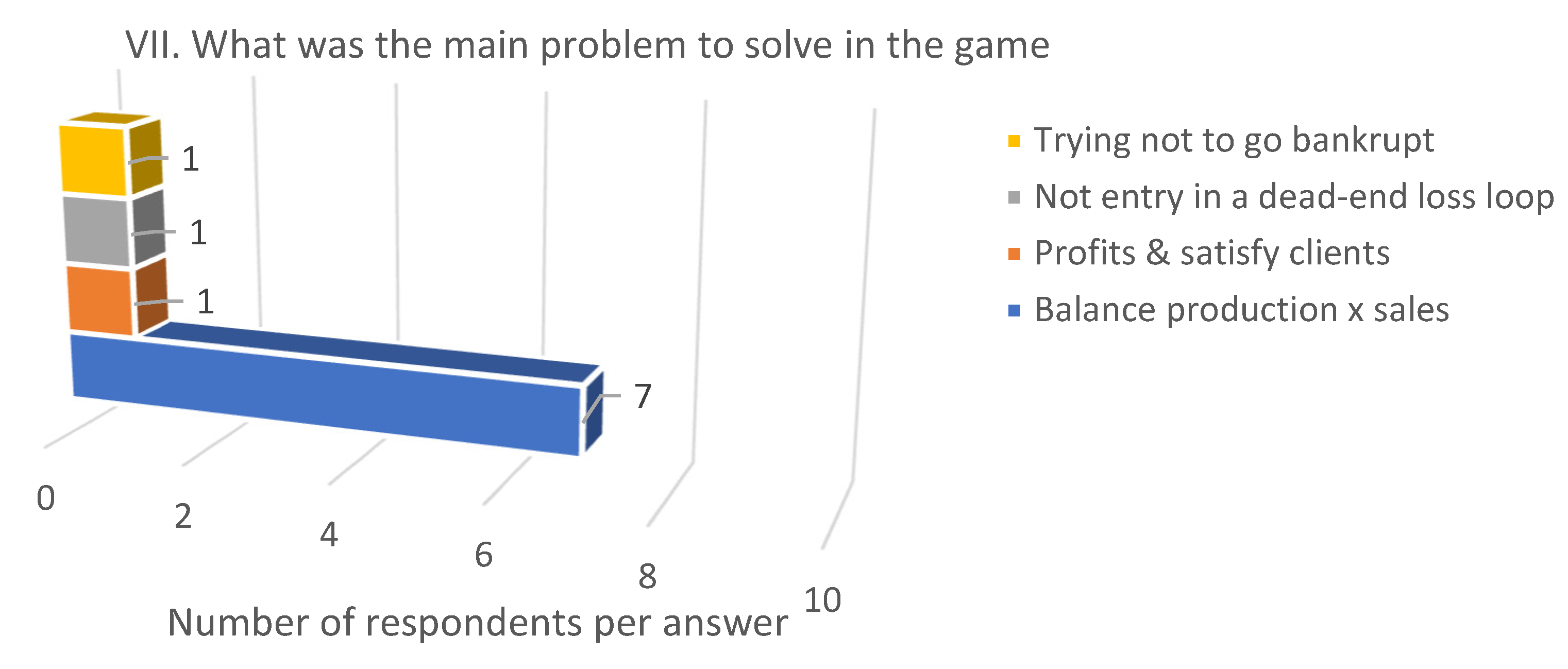
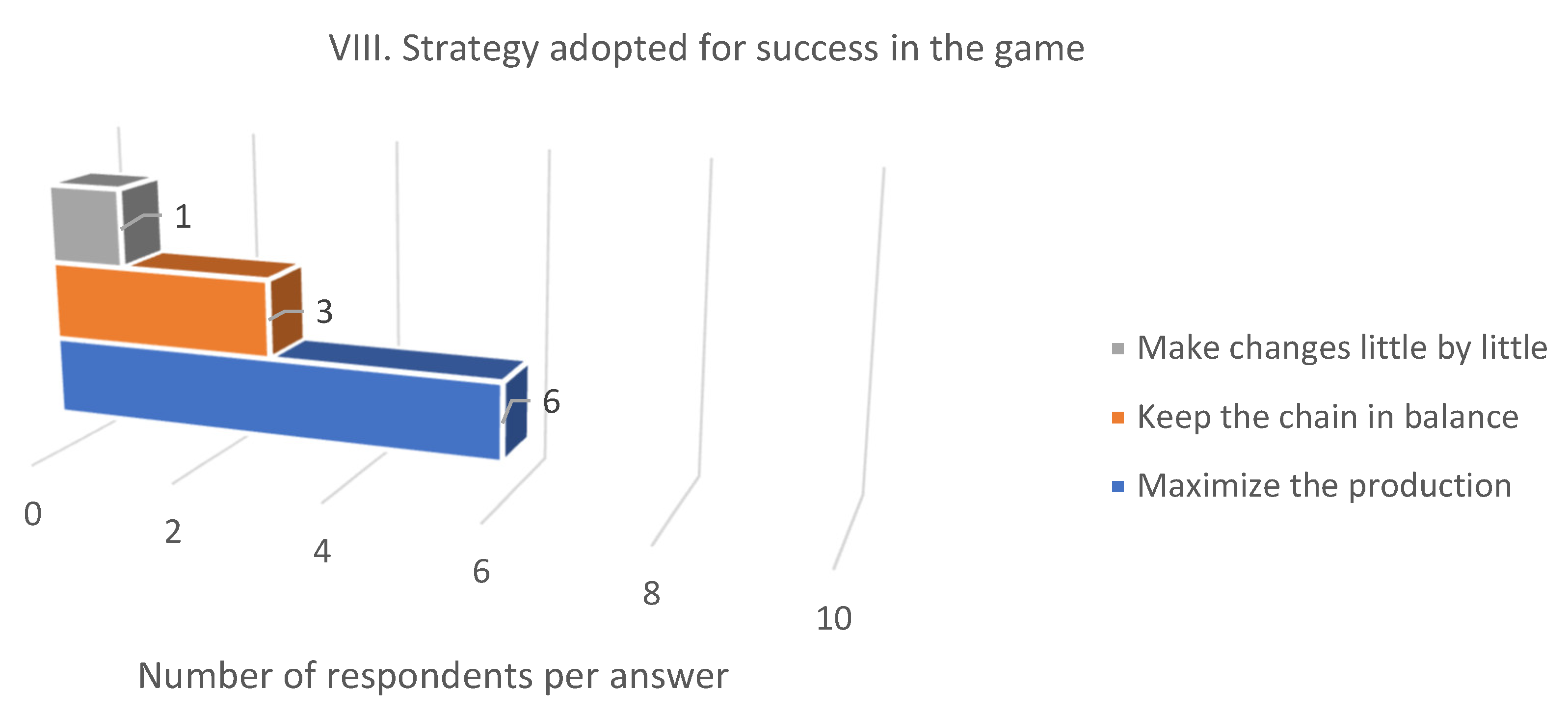
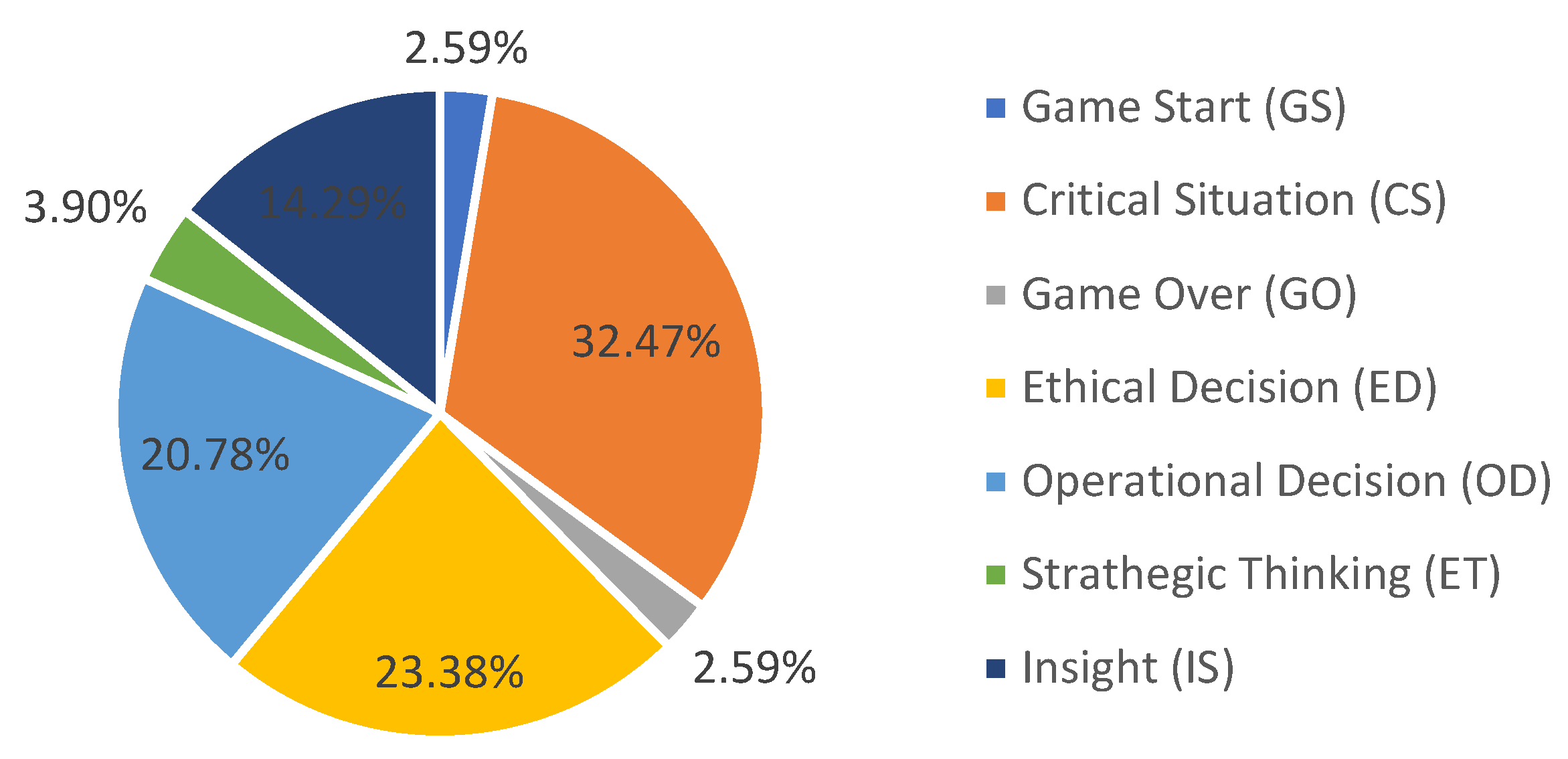
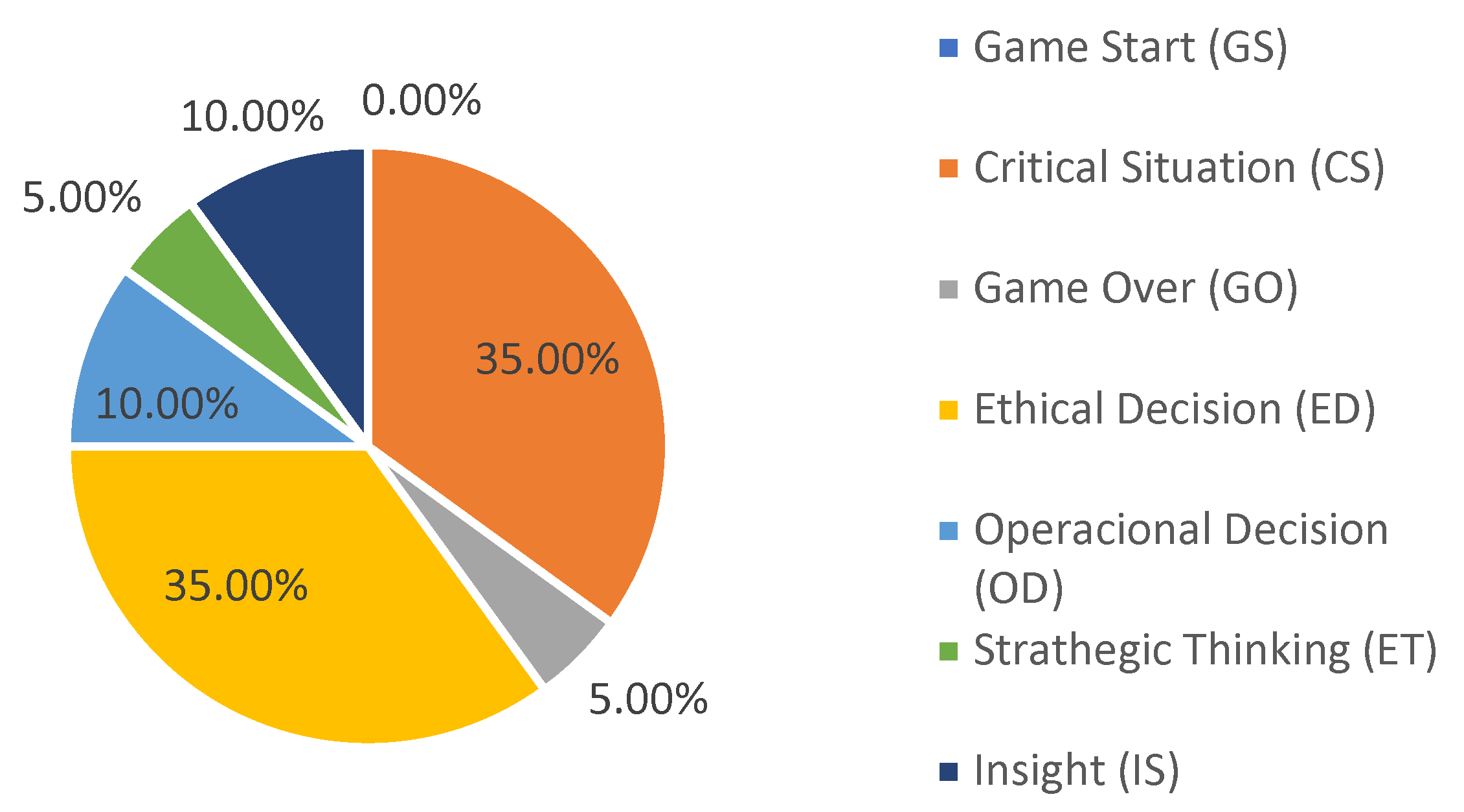
| Instrument | Instrument Deliveries | User Engagement Component | Player Experience Method |
|---|---|---|---|
| HEG | Flow tendency | Cognitive engagement | Physiological |
| ET | Attention aspects | Behavioral Metric | Behavioral |
| Pre- and Posttest | Value perception | Self-reported engagement | Psychological |
| Pretest Questions | Posttest Questions |
|---|---|
| Genre | (I) Did the devices, room or other elements used to perform the data collection make it difficult to run the test? |
| Age | (II) Did the in-game tutorial seem appropriate for you? |
| (I) Have you had any previous experience with business simulation games? | (III) Did the game environment help you to understand the aspects involved in running a company? |
| (II) Do you often have fun with computer games? | (IV) Was the speed of the game adequate for the understanding of the problem presented? |
| (III) Do you have any professional experience or knowledge taken in Business Management? | (V) Was the number of variables you could modify adequate to understand the proposed problem? |
| (IV) What do you consider most important in a simulator or game? Images, Interaction, Difficult Level, Unexpected situations, User scenarios, Results after change variables | (VI) What did you consider most important in the experienced game? Images, Interaction, Difficulty Level, Unexpected situations, User scenarios, Results after change variables |
| (VII) How would you describe or main problem to solve in this game to keep the company running and financially balanced? | |
| (VIII) What was your strategy to solve the problem described in the previous question? |
Publisher’s Note: MDPI stays neutral with regard to jurisdictional claims in published maps and institutional affiliations. |
© 2022 by the authors. Licensee MDPI, Basel, Switzerland. This article is an open access article distributed under the terms and conditions of the Creative Commons Attribution (CC BY) license (https://creativecommons.org/licenses/by/4.0/).
Share and Cite
Ferreira, C.P.; González, C.S.G.; Adamatti, D.F. Player Engagement Analysis of a Business Simulation Game from Physiological, Psychological and Behavioral Perspectives: A Case Study. Appl. Sci. 2022, 12, 10143. https://doi.org/10.3390/app121910143
Ferreira CP, González CSG, Adamatti DF. Player Engagement Analysis of a Business Simulation Game from Physiological, Psychological and Behavioral Perspectives: A Case Study. Applied Sciences. 2022; 12(19):10143. https://doi.org/10.3390/app121910143
Chicago/Turabian StyleFerreira, Cleiton Pons, Carina Soledad González González, and Diana Francisca Adamatti. 2022. "Player Engagement Analysis of a Business Simulation Game from Physiological, Psychological and Behavioral Perspectives: A Case Study" Applied Sciences 12, no. 19: 10143. https://doi.org/10.3390/app121910143
APA StyleFerreira, C. P., González, C. S. G., & Adamatti, D. F. (2022). Player Engagement Analysis of a Business Simulation Game from Physiological, Psychological and Behavioral Perspectives: A Case Study. Applied Sciences, 12(19), 10143. https://doi.org/10.3390/app121910143










